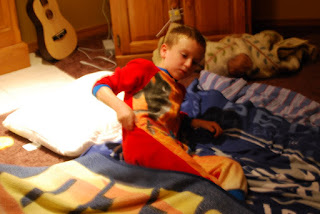
We’re trying to relax in our hotel room after being rained out at Disney. We have a nice suite with separate bedrooms for the kids. But right now, Emily and Beth are jumping on their beds.
I storm into their room. Stuffed animals litter the beds. Covers and pillows have been strewn across the floor. The kids freeze when they see my “knock it off this instance” face.
“Sit down and be quiet.” I order. They obey, but only for a few minutes.
It’s not that I object to a little fun. But experience tells me that either one of the kids will fall off the bed and start screaming. Or someone will accidentally (on purpose) hit someone else and there will be screaming. Screaming in a hotel room is not a good thing.
When traveling with three children under the age of eight, you have to expect a certain amount of turmoil. There’s spilled drinks in the back of the minivan, an endless chorus of “are we there yet” and hours of “he’s looking at me again.” It can get a bit overwhelming.
I chalk all of this pandemonium up to the “chaos coefficient.” You never heard of it? Let me explain. From a mathematical standpoint, a coefficient is a value used to modify a mathematical expression or define a relationship between variables. In other words, it’s a multiplier.
The chaos coefficient is similar. It represents that amount of chaos brought to any situation and it is directly proportional to the number of children that are entered into the equation.
For example, take the act of going out to a restaurant for dinner. If you are a couple without children, you can get out the door in a few simple steps. Step one, get showered and dressed. Step two, shoes on. Step three, out the door. Total prep time, about thirty minutes. Easy peasy lemon squeezy.
Now add two year old into the same formula. The problem becomes considerably more complicated. It might look something like this.
Step one, bathe the child. Step two, scream “Stop running around the house naked” as you chase a wet child through the house. Step three, dress the child. Step four, play hide and seek looking for the child’s shoes. Step four, discover your child had undressed herself. Repeat step two. Step five, find one shoe under the couch. Step six, find you child playing with the other shoe in the cat’s litter box. Step seven, repeat steps one through three. Step eight, stop at Walmart to buy new shoes before going to the restaurant. Total prep time, about two hours.
Step one, bathe the child. Step two, scream “Stop running around the house naked” as you chase a wet child through the house. Step three, dress the child. Step four, play hide and seek looking for the child’s shoes. Step four, discover your child had undressed herself. Repeat step two. Step five, find one shoe under the couch. Step six, find you child playing with the other shoe in the cat’s litter box. Step seven, repeat steps one through three. Step eight, stop at Walmart to buy new shoes before going to the restaurant. Total prep time, about two hours.
 Yes, that’s the chaos coefficient. But it doesn’t stop there. The chaos coefficient is exponential. The more kids, the more chaos. Two kids mean ten times more bedlam than one. Three kids create a hundred times more disorder. And so on. That's why it takes a normal family twenty minutes eat breakfast but it takes our family three days.
Yes, that’s the chaos coefficient. But it doesn’t stop there. The chaos coefficient is exponential. The more kids, the more chaos. Two kids mean ten times more bedlam than one. Three kids create a hundred times more disorder. And so on. That's why it takes a normal family twenty minutes eat breakfast but it takes our family three days. Walking through Disney World with three kids strung out on pixie dust creates a logarithmic effect to the chaos coefficient. There’s the flashing lights, the spinning rides, the bright balloons, the Princesses and giant mice. The ultimate effect is off the scale.
But lucky for me, the impact of the chaos coefficient is easy to negate. You just add in a little of the “I Love You” factor and it’s all good again.



















